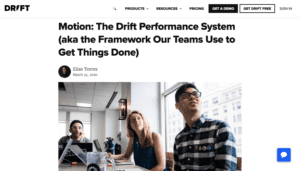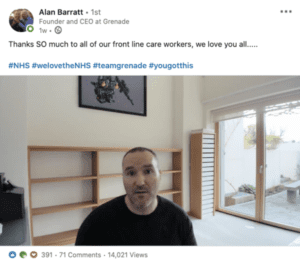
Are you ready to put your employees at the center of your brand’s communications?
This article was originally written for Business 2 Community and was published on April 6, 2020. Last updated: 26th February 2025.
In 2020, brands are waking up to the fact that buyer attitudes are changing. Put simply, people no longer trust brands.
Of course, there are exceptions, but nowadays, people are more likely to follow the people who work for an organization than the company itself.
In every sense, employees are becoming the face and voice of organizations.
For a while, brands have been trying to combat this decline in trust, namely through the use of social media influencers and product placement.
However, as is too often the case, buyers became increasingly savvy to this new form of marketing following changes in consumer protection law and one too many well-publicized blunders.
In recent months we’ve seen a steep incline in brands conveying important updates and messages via their employees.
With the now well-documented pandemic taking full effect, senior management and less-senior staff alike have been taking to social media to assure their client base, customers, and followers that the business is operating despite the public health emergency.
In 2019, we saw a spike in articles and research that declared a want for transparency and authenticity from brands, as buyers have become increasingly frustrated by those not fulfilling expectations or partaking in one too many dodgy dealings. Think 2018 when the scandal arose surrounding Cambridge Analytica that left Facebook having to answer to more than just the court of public opinion.
The solution is simple but clear: people trust those they know. A study conducted by Olapic found that 76% of people are more likely to trust someone they know over any form of branded content.
How are brands using people to communicate if social media influencers aren’t working?
The answer is the most untapped resource for companies of all shapes and sizes: their employees.
Here’s how your organization can leverage your employees’ networks to effectively disseminate information, promote and enforce operational transparency, and restore trust to build a truly people-based organization.

Encourage your employees to make some noise on social media. When they talk, people listen! (Photo by Andrea Piacquadio)
Leverage Your Employee Influencers
As a business, your employees are some of your most trusted and reputable ambassadors.
They are your internal influencers. Many will be experts in both your company and industry.
Not only this, but employees have an average network size of 1,180 people.
According to research conducted by LinkedIn, if you total that up, your employees will have an average cumulative reach of more than 10x your corporate accounts. That’s quite the audience!
Specialists in strategic communications and engagement, MSL Group, found that brand messages are shared 24 times more frequently when employees shared them.
This shows that in today’s climate, which is lacking in both certainty and consumer trust, to truly amplify your message, your employees should be at the center of your communications.
The logic and theory behind employee influence is something of a no-brainer to us.
Firstly, you have the marketing benefits of amplified reach, increased engagement, maximized social selling, and reduced cost-per-click, to name just a few benefits.
With the studies and statistics mentioned above taken into account, there’s no denying that your content could reach and engage a much broader audience if your employees collectively share.
Look no further than the sports nutrition brand Grenade for examples of exceptional employee influence and using employees to lead the charge in company communications.
The brand exudes positive company culture, with the company holding what appears to be a fairly relaxed social media policy, as employees frequently share behind-the-scenes content on LinkedIn and other sites.
Often, just one influential employee will generate more engagement on their post than the brand itself.
Grenade’s power to leverage its employees’ influence was recently demonstrated when it launched its first-ever Easter egg. Employees discussed it on social media before the product was officially launched.

Grenade pulls in significant engagement on their corporate pages, but the highest performer was a post from one very influential employee! (Sophie Thomas, Ruby McKenzie, and Grenade on LinkedIn)
The second most significant benefit of an employee influencer program is the branding, and employer branding benefits it yields.
Actively encouraging your employees to create and share content on behalf of your organization is a fantastic way to empower your workforce.
It displays trust in your employees to represent the brand online, showing that they are just as much a part of the business as senior leadership.
Alongside employee empowerment, employee influencers allow you to showcase your company culture on social media.
Displaying positive company culture via your employees carries with it two main benefits:
Crowdsourcing authentic employee-generated content from your team while promoting your employer brand to a sea of potential top candidates.
Your employee influencers give the public a chance to see what life is really like at your company.
Take a look at the conversational marketing platform Drift, for example.
Drift has famously stated that they never use stock photography.
Everything you see is in-house and genuine. From their slide decks and resources to their brand book, what you see is what you get with Drift!
Not only do practices like this display full transparency, but they give a potential candidate a genuine look at what it’s really like to work there.

Drift operates with full transparency when it comes to its imagery, insisting on only using in-house photography (photo from the Drift blog)
It’s no secret that one of the biggest challenges facing marketing teams is creating this level of company content at scale.
Most companies rely on their social media community manager or agency partners to take pictures and videos, but they can’t be everywhere at once.
No doubt, as a business, you will already have employees who are on social media and actively advocating for your organization, though you may not know it yet.
In fact, a study from Weber Shandwick found that of those surveyed, 39% of employees had spoken positively about their employer on social media.
Whether by sharing your content or posting content they’ve created, your employees already post about your company on social media.
The key is to leverage and encourage this activity.
Encouragement can come in the simplest of forms. It could be a like, a comment on their post, or a thank-you email!
If you’re having trouble finding your employee influencers, a helpful tip is to search your company name and company-related hashtags on social media.
And the most effective way to leverage your employees’ efforts and amplify your content is to centralize this activity within an employee influencer platform.
Platforms like DSMN8 offer internal communications and automation features, and you can even incentivize content sharing with competitive leaderboards and rewards.

Getting senior leadership active on social media is a fantastic way to disseminate important company updates and information.
Senior Leadership Must be Active on Social Media
In the current world of business, senior leadership, namely C-Suite executives, are just as much a part of a brand’s identity as its products and services.
When they join a business, a CEO or other C-Suite executive brings their unique personal brand and network with them. Throughout their career, they have often amassed large social media followings.
In the past, it was unheard of for leaders to be present in the day-to-day running of a business, and most employees were likely unfamiliar with them outside of work. The best they could hope for was messages passed down from one leader to the next, who passed it on to middle management, who passed it on to other managers, and so on.
We now live in the age of the social CEO.
By being active on social media, senior leaders can put themselves right in front of their employees to communicate in a way that is both personal and accessible. It also gives them the power to control the brand’s narrative and communicate with their audience in an instant.
A shining example of an effective social CEO is Alan Barratt. Alan Barratt is the CEO of the previously mentioned sports nutrition brand Grenade. Barratt regularly features in company content and has a huge presence on social media, even hosting the brand’s popular ‘Pull the Pin’ podcast.
When leaders are active on social media, they offer people the chance to connect with them (and your business) on a human level, whether they’re followers or employees. This makes their profiles the perfect platform to distribute your most important company information and updates.
Related post: The 5-Step CEO Content Framework.

Barratt’s presence on social media has been brilliantly effective in relaying company information during the COVID-19 pandemic (Alan Barratt on Linkedin)
Why is this important?
Well, it’s rather simple: a good leader is not just one who leads the business forward but one who leads its employees in the same direction.
In order for senior management to get people to buy into the brand and the brand’s vision, they must get people (whether employees, potential buyers, or clients) to believe in them.
How is this done? In a word, transparency. Communication and authenticity are key ways to exercise operational transparency and get people behind your brand.
What we’re seeing in 2020 is what separates employee advocacy from employee influence. The difference is that while an employee advocate will share your company content, an employee influencer will have a demonstrated investment in the brand and will want to see it prosper, come rain or shine.
Transparency and trust are key qualities businesses and consumers are looking for in brands right now. As consumer trust has weakened, people are seeking out reputable brands with whom they can establish lasting relationships.
People trust people, and people buy from people.
Your employees need to be at the center of your communications to take your brand to the next level.
Are you ready to put your employees at the center of your brand’s communications?
Learn more about employee advocacy and influence:
- Facing Marketing Cutbacks? How To Do More With Less
- The Foolproof Guide To Getting More LinkedIn Engagement
- How To Become a Thought Leader
Lewis Gray
Senior Marketing Manager and Employee Advocacy Program Manager at DSMN8. Lewis specialises in content strategy, growing brand visibility and generating inbound leads. His background in Sales lends itself well to demand generation in the B2B niche.


